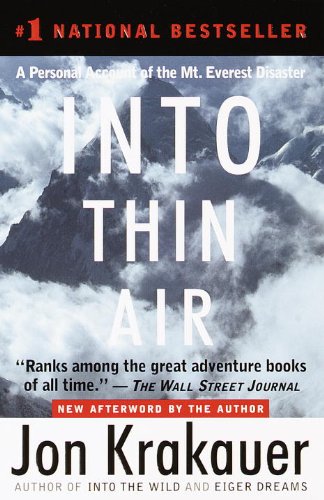All Nonfiction
- Bullying
- Books
- Academic
- Author Interviews
- Celebrity interviews
- College Articles
- College Essays
- Educator of the Year
- Heroes
- Interviews
- Memoir
- Personal Experience
- Sports
- Travel & Culture
All Opinions
- Bullying
- Current Events / Politics
- Discrimination
- Drugs / Alcohol / Smoking
- Entertainment / Celebrities
- Environment
- Love / Relationships
- Movies / Music / TV
- Pop Culture / Trends
- School / College
- Social Issues / Civics
- Spirituality / Religion
- Sports / Hobbies
All Hot Topics
- Bullying
- Community Service
- Environment
- Health
- Letters to the Editor
- Pride & Prejudice
- What Matters
- Back
Summer Guide
- Program Links
- Program Reviews
- Back
College Guide
- College Links
- College Reviews
- College Essays
- College Articles
- Back
Into Thin Air by Jon Krakauer
Jon Krakauer’s Into Thin Air was a first hand look into one of the most dangerous seasons in Everest climbing history. Krakauer writes the book in a very logical way. As I was reading, I was amazed at just how many things went wrong on the expedition. He includes at least 100 pages worth of information on past seasons of climbing, as well as a history of the first people to reach the peak. It seems one of the downsides to this book, however, is that, unless you’re a climber, the story can be slightly confusing. He uses many climbing terms and it’s hard for non-climbers, like myself to comprehend all of the dangers and challenges of summiting Everest. Fortunately for the reader, he uses footnotes to explain some possible confusion as well as the background information he includes on climbing. The most gripping part of Krakauer’s story isn’t the climb up, but rather the journey down the mountain, and the events that followed. The book isn’t entirely Krakauer’s account of what happened, but also interviews with other members of the expedition to piece together their story. This point of view change is a very sophisticated form of writing that makes the book even more interesting. I noticed a lot of judgment that Krakauer makes, mostly on himself, but on others as well. He forms opinions based on bad decisions that sherpas and climbers made by not turning back at the designated time. There was a lot of survivor guilt that Krakauer went through. He goes into good depth with this near the end of the book.
One of the things I liked about his writing structure was that the first chapter took place just as he was leaving the summit. He included enough dilemma to hook the reader, but also didn’t give away any of the story. Krakauer also has a very strong tie to the guides that are taking his group of 11 up the mountain. Rob Hall and Andy Harris are highly praised by Krakauer. He talks about Hall’s great reputation and the friendship he formed with Harris. He gives a lot of the other climbers slightly negative connotations, which made it somewhat biased against these people. But, despite his swayed opinions, this was an exciting story with interesting background and Krakauer did an excellent job at portraying the events of May 10, 1996.
Similar Articles
JOIN THE DISCUSSION
This article has 0 comments.

